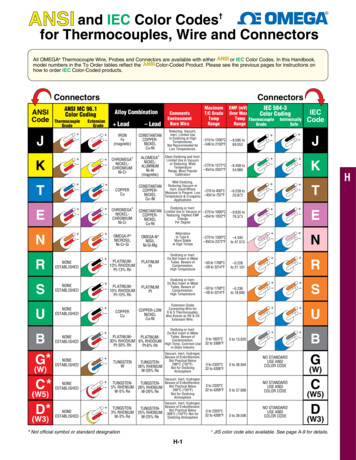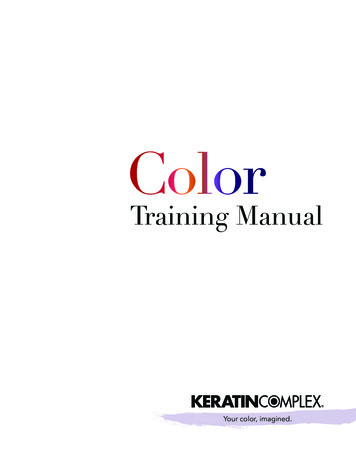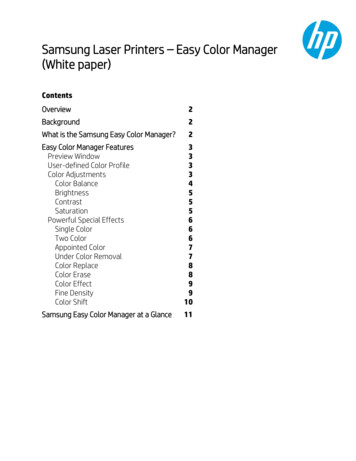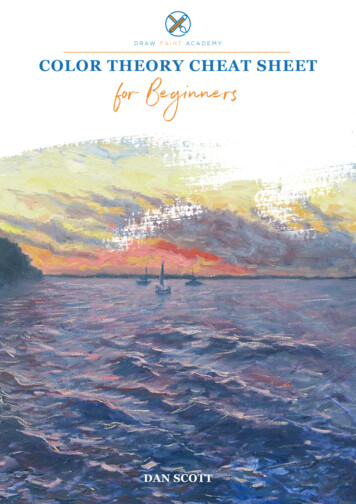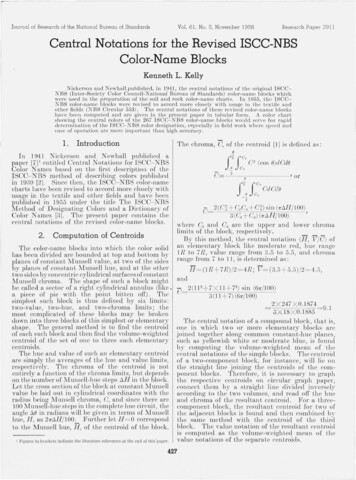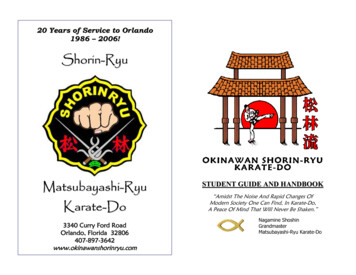
Transcription
20 Years of Service to Orlando1986 – 2006!Shorin-RyuMatsubayashi-RyuKarate-Do3340 Curry Ford RoadOrlando, Florida 32806407-897-3642www.okinawanshorinryu.comSTUDE T GUIDE A D HA DBOOK“Amidst The Noise And Rapid Changes OfModern Society One Can Find, In Karate-Do,A Peace Of Mind That Will Never Be Shaken.”Nagamine ShoshinGrandmasterMatsubayashi-Ryu Karate-Do
A Special Note from RenshiNOTES:The Orlando Okinawan Shorin-Ryu Karate-Do Dojo isdedicated to providing the best instruction in traditional karatein a Christian environment.This school, founded in the same location in 1986, pridesitself on the practice of “traditional” Okinawan karate.Traditional karate demands the mind, body and spirit betrained as one. As our late Grand Master Nagamine Shoshinsaid;“The mastery of karate-do requiresdedication and strenuous effort. Topursue karate means to seek to masterone’s self.”Although proper technique andintellectual understanding are important,we are equally concerned with theHanshi Nagamine Shoshinstudent’s attitude and dedication.1907 - 1997Students need to demonstrate awillingness to learn and a tenacity to never give up.Information About Our School & StaffGrandmaster: Nagamine Shoshin, Founder of StyleStyle Master: Nagamine Takayoshi, 10th Degree Black BeltOwner: Geoffrey Gaudoin, 6th Degree Black BeltCo-Owner: Trish Gaudoin, 4th Degree Black BeltStyle Federation:U.S. Matsubayashi-Ryu Karate-Do FederationFederation President:Mike Ritter, 8th Degree Black Belt- 1 --- 14 -
Counting in e Maxims“Karate Ni Sente Nashi”There is no first attack In Karate.Katas Practiced by Matsubayashi-Ryu Karate-DoFukyugata IchiFukyugata NiPinan(Sho-dan to Go-dan)Naihanchi(Sho-dan to hoChintoKusankuINTRODUCTIONWhether a person is only considering a study of the art of karateor is actually beginning such a study, it is necessary to view karatewith a proper perspective. Many people are intensely interested inkarate or other martial arts but are wary about embarking on acourse of instruction in one of the martial arts because of their manymisconceptions. I hope, by way of this introduction, we can removemany of these misconceptions plaguing the new student.The whole person concept is emphasized in this karate club.The achievement of one’s potential spiritually, mentally andphysically is stressed. Karate combines the body, mind and spirit ina harmony of the whole person in order to approach perfection inthe art.Our primary goal in life should be devotion to God, thus thiskarate club operates with Christian values and ideas. These valuesand goals include academic knowledge, physical fitness, devotion toGod, a serene family life and recognition by your fellow humans as acontributor to the society in which we live. To do this you mustdelegate karate to it’s proper place in life - - don’t become a KARATEFANATIC! Learn balance in all things.Physical fitness, awareness, selfconfidence, discipline and self defenseare taught and are equal in importance.At no time should you place the selfdefense phase uppermost in your mind.To do so will inevitably bring chaos andunhappiness to your life.The study of karate is not a shortterm goal but rather a life long endeavor.It is a journey not a destination andobtaining the black-belt is not a symbolof the end, but of the beginning. AsMaster Kyan said;“A mastery of karate does notdepend upon the learner’s physicalcondition, but mainly on constant practice.”- 13 --2-GAUDOIN RENSHIDOJO FOUNDER &OWNER
HISTORY AND BACKGROUNDThe words “Shorin-Ryu” refer to a specific style or type of karate whichoriginated on the island kingdom of Okinawa long before karate wasintroduced to Japan.Each style of karate has it’s own distinguishing features such as kataforms as well as ways of punching and kicking. The word “ryu” meansstyle while the word “Shorin” is the Okinawan pronunciation of the Chineseword “Shaolin.” So Shorin-Ryu actually translates to mean Shaolin style.This is a reference to China, specifically the Shaolin Monastery inNorthern China, where empty hand martial arts (originally called Kung-Fuin Chinese) began. Before Okinawa was occupied by the Japanese, it wasthe autonomous kingdom of Okinawa with its own language (UchinaGuchi), culture, social and political structure.Okinawa was originally very close culturally and politically to China. Itwas this association which allowed Chinese monks and noblemen to carryShaolin Wu Shu (Kung Fu) to Okinawa. Upon being exposed to Shaolin WuShu, the native Okinawans combined it with the island’s indigenous martialarts known as Te, or hand. The hybrid system became known as To Te orTode which literally translated to mean “China Hand.”Martial arts legend holds an Okinawan nobleman, Sakugawa, as beingdirectly responsible for learning Shaolin Wu Shu in China and thenreturning to Okinawa as it’s first Okinawan Master. Sakugawa was also thefirst man to open an actual karate school in Okinawa. Because of hismastery of this martial art system he is still known as “To Te Sakugawa.”As the years past, different teachers founded different Ryus or styles.The Shorin-Ryu system remains a direct descendent of the earlier Shaolinart. The main difference between the two is the Chinese system reliesheavily on open hands whereas the Okinawan systems uses more closedfists. This is attributable to the incorporation of Okinawan Te which meanshand or fist.Originally the Shorin system was concentrated to an area aroundTomari village in Okinawan. The system grew to include four distinct Ryus;Matsubayashi-Ryu founded by Nagamine Shoshin, Matsumura-Ryu(Orthodox) by Soken Hohan, Kobayashi-Ryu by ChibanaChoshin & Shobayashi-Ryu by Kyan Chotoku.While our system is primarily a hand techniqueoriented style there is no one “best” style of karate.Styles developed differently based on needs, terrain,climate and other factors. All traditional martial artsshould be respected.-3-JAPANESE TERMINOLOGYThe following are common Japanese terms used in class day-to-day.All students are expected to learn and use them. There are more, whichwill be learned as the student progresses.TERMJAPANESELine UpAttentionReadySit DownBowPlease Teach MeThank You Very MuchYou’re welcomeWay of the Empty HandSenior InstructorTeacherStudentMasterHouse of InstructionForms (Stylized Fighting)Striking in (start)StancePush-UpsExcuse me (sorry)Just a moment pleaseI understandHow are you?YesNoShugoKyotsukeYoiSeizaReiOnegai ShimasuArigato GozaimasuDo itashimashiteKarate-doRenshiSenseiDeshi or eZukiKeriHidariMigiHajimeDachiUdetate FuseSumimasenChotto matte kudasaiWakarimashitaOgenki desu ka?HaiIie
QUESTIONS & ANSWERS ABOUT PROMOTIONS1. How often are promotions held? - Promotions are heldevery three months. However, that does not mean you will betested every three months. Various ranks have different timerequirements, in addition the individual student must show they areready for advancement through their abilities, attitude andattendance at the dojo.FEES AND DUESAs a traditional school, we do not utilize contracts.Contracts are for businesses; we are a martial arts school.Fees are due at the beginning of the month. Monthly feesinclude insurance and federation dues. We have to charge alate fee for those dues not received by the 10th of the month.We appreciate prompt payment of dues.2. How much time must I wait between ranks? - The timebetween ranks ranges from 24 – 36 classes depending on thespecific rank.3. What are the requirements for promotion? - Therequirements for promotion are contained in a book located in thetop drawer of the filing cabinet in the dojo. The book is open to allstudents and should be reviewed often.4. What is the actual promotion process? - As you attendclass and improve in ability it is up to you to get signed off as beingready for promotion. On your attendance card are sign-off blocksfor technique, essay, kata, questions, etc. Any Sensei or Brown beltcan test you on these areas and sign you off in preparation forformal testing. Renshi will notify you when you are testing. NOTE:Traditionally it is asign of discourtesy toask Renshi to test you.When you are ready totest Renshi will know.5. What is the propercourtesy to show duringtesting? There is a poster of“Testing Etiquette”located in the dojo.Please become familiarwith it.- 11 -Promotion fees are due prior to the day of the promotiontest. We require this in order to save time on testing day sothe examiner(s) can concentrate on the test, not paperwork.You may not be allowed to test if fees are not paid prior to thetesting date.SPECIAL EVENTSFrom time to time we have specialevents. We will let you (and your child)know during class what we’re planningand if there are any fees associatedwith the event.We have an annual Christmasparty in which we invite family andfriends for a meal and a karatedemonstration put on by our studentsand instructors. We also have otherspecial events such as a beach party,parent’s night out, etc.Renshi will notify you of theseevents at practice sessions.-4-
CLASS SCHEDULESMonday .Beginners Class (open to all ranks)Tuesday .Advanced Class and Kinder KarateWednesday .ClosedThursday .All StudentsFriday .All Students OTES:Kinder Karate Class is held from 5 to 6 PM on Tuesdays.Children’s Classes are held from 6 to 7 PM Monday through Friday(closed Wednesday).Adult classes are from 7 to 8:30 PM Monday, Tuesday, Thursdayand Friday from 7 to 8 PM.Advanced children’s classes are open to Orange belt & above.Advanced Adult classes are for ranks of Green belt and above.All workout sessionsstart with warm-up,stretching andexercises beforemoving into thebasics. Once this iscomplete, newtechniques and/orkatas are taught bythe instructors.Sparring (or kumite)will occur on afrequent basis andwithout prior notice, STUDENTS PRACTICING FUKYUGATA - ICHI INFRONT OF SHURI CASTLE, OKINAWA, 1941so you need to beready. To be eligible for kumite you must have first obtained therank and have Renshi Gaudoin’s permission.THE DOJO WILL BE CLOSED FOR THE FOLLOWINGHOLIDAYS AND EVENTS:New Year’s Eve & DayLabor DayHalloweenGood Friday thru Easter SundayMemorial Day4th of JulyThanksgiving WeekendChristmas BreakTHE OBI (Belt)Do’s and Don’ts:1.2.3.4.5.Don’t eat or drink while wearing the obi.Don’t wear the obi outside of the dojo.Don’t wash the obi.Do respect the obi and don’t let it touch the ground.Do take the obi home and remember to bring it to class.AdultObi �sObi Colors:WhiteYellowOrangeRed, Blue and PurpleHow to Tie Your Obi:Steps 1 & 2: Wrap the obi twice around yourWaist With the left end on top. Adjust it tomake both ends the same length.Step 3: Tuck the left end under both folds of the belt.Step 4: Fold the right end of the obi back toward your right.Step 5: Fold the left end over the right end.Step 6. Tuck the left end of the obi up through the loopformed by the right endStep 7. Give both ends a half twist inward to make the knotlie flat.- 10 -
DOJO ETIQUETTEBowing: In the Orient a bow meansmuch more than a handshake here inAmerica. When two people bow toeach other it is clear who is of higherrespect (rank). The junior individual(regardless of rank) bows deeper to ahigher rank individual. Peers bow thesame depth to each other.Shoes: Shoes are NEVER to be wornonto the dojo floor. A shoe rack islocated at the dojo entrance.Cleanliness: The dojo floor is swept, wet mopped and the carpetvacuumed after Friday’s class or whenever it is needed.Traditionally, Kyu ranked students perform these duties as a sign ofrespect to the school. If a Kyu student sees a Black Belt cleaningsomething in the dojo, it would show great respect if they wouldvolunteer to take over for the Sensei.WEAPONS CLASSESWeapons are a paradoxin Karate. Traditionally,there are no weapons inkarate other than thehuman mind and body. Atthe same time, Okinawansdeveloped sophisticatedweapons out of primitivefarm implements. The studyof these ancient weapons is known as Kobu-Jitsu or Kobu-Do.The development of Karate and Kobu-Do occurred almost at thesame time. As a result Kobu-do has always been studiedconcurrently with karate. When one watches a weapons form it iseasy to see the parallels between it and karate in the stances andmany of the moves.Our style utilizes 5 of the traditional Kobujitsu Weapons; theNunchaku (Rice flail), the Sai (trident), the Kamas (hand sickles),the Tuifa (millstone handle) and the Bo (6 foot staff).Because Kobu-Do requires an understanding of the basics ofkarate, students do not begin working with weapons until they areeligible to attend advanced classes.Body Fluids: On rare occasions a student will scrape a knee, toe,finger or the like. At any time there is visible blood, the studentshould stop whatever activity they are involved in and inform aSensei. Activities will resume after cleaning has been accomplished.First aid supplies are located in the restrooms.Physical Fitness: Everyone will grow in physical strength andendurance as they continue to train in karate. When a studentstarts, while they are expected to give their best effort, they are notexpected to continue at 100% if they experience shortness ofbreath, dizziness, lightheadedness, feel faint or feel pain or pressurein their chest. If you develop one of these symptoms, bow to theSensei and excuse yourself. Leave the deck and sit down for amoment. If the sensations do not go away rapidly after you relax,notify the Sensei IMMEDIATELY.-7--8-
DOJO RULES1. No profanity or abusive language will be allowed in the dojo.2. All members will remove their shoes before entering the dojopractice deck.3. All members will bow to each other at the beginning and end ofeach class.4. All members will bow to Renshi when entering and leaving the Dojo.5. All members will bow when coming onto and leaving the dojo floor.6. Personal cleanliness and hygiene are to be observed at all times.7. Keep your fingernails and toenails short at all times.8. Keep your karate uniform (Gi) neat and clean at all times.9. Do not wear rings, jewelry or any other metal ornaments on thekarate deck.10. Do not leave personal belongings in the dojo overnight.11. No candy, gum, food, or beverages of any kind will be allowed onthe karate deck. No smoking in the dojo at any time by studentsor spectators.12. Do not come to class while intoxicated. Do not consume anyalcohol before class or practice.13. No talking or laughing at any time while class is in session.14. Help students below you in rank with knowledge.15. Refrain from misusing your karate knowledge.16. Do not show anyone, who is not a club member, any karatetechnique and do not demonstrate karate in public.17. Stay out of fights unless impossible to avoid. Report all fights toRenshi within 24 hours.18. Do not criticize other members at anytime.19. Be on time for class. If you are late, do 25 push-ups then assume aseizan sitting position at the back of the dojo floor until Senseimotions for you to join the class.20. The karate teacher is to be called Sensei at all times while in theDojo.21. Signs and periodic postings are to be observed at all times.22. Strive to promote the true spirit of karate by the development of;a. Respect (Courtesy to others)b. Character (Mental development)c. Humility (Never lose sight of your shortcomings)d. Health (Physical development)e. Skill (Proficiency in karate)-9-NOTES TO PARENTSParents, we need to ask for your help in ensuring yourchild receives the best in karate training. To that end, thereare a few rules which need to be observed in the dojo.1. Please do not, under any circumstances, call to or talk withyour child while class is in session. Should you have anemergency that cannot wait until after class, motion to one ofthe black belt instructors and speak with them. It is veryimportant for the instructor to have your child’s full attentionduring class.2. At times your child will be assigned a task to complete. Itmay be to bring in a permission slip, to do a chore at the dojoor such. This is their responsibility, not yours. If necessary,gently remind your child of the task but do not do it for themof force them to accomplish it. The instructors will provide theincentives.3. If you have a problem with the instruction or somethingthat has happened in class or at a special event, please talk toRenshi directly. We are glad to meet with you and discuss anysituation.4. For some promotions, an essay is required on a specificsubject. This should be done by your child, not by you.Certainly you may help with suggestions, but this is a time forthe student to do the research and/or express their thoughts.5. Please observe quiet when class is in session.6. Parents should pick-up their children inside the dojo. Weask this for three reasons: (1) We want to keep your childrensafe, (2) This will ensure you hear any specific announcementsand (3) This will give Renshi a chance to speak with you aboutyour child if it is necessary.We greatly appreciate your cooperation!-6-
Shaolin Wu Shu (Kung Fu) to Okinawa. Upon being exposed to Shaolin Wu Shu, the native Okinawans combined it with the island’s indigenous martial arts known as Te, or hand. The hybrid system became known as To Te or Tode which literally translated to mean “China Hand.” Martial a

